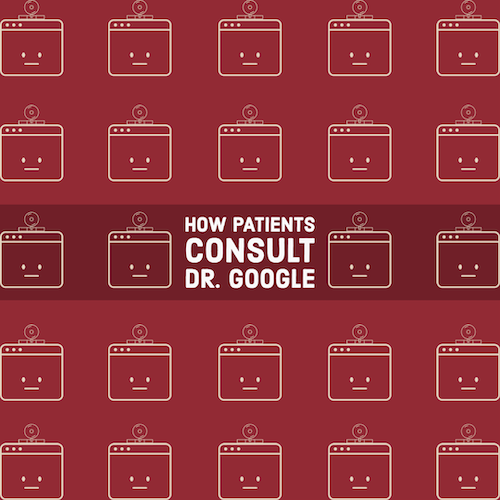Health, wellness, and medical searches are among the most popular search queries on Google. The majority of patients now look up their symptoms online before they visit their doctor, just as the majority of people check out products online before they ever walk into a store. You can call it “the empowered consumer,” but in the medical profession the phenomenon is coming to be called “Dr. Google.”
Patients come in with a diagnosis from Dr. Google rather than an open mind. Often they have already tried some prescriptions from Dr. Google, too — in the form of supplements, over-the-counter products, or home remedies.
While it’s great that patients and consumers can access more information than ever before, the idea that watching a video about scapular stabilization makes you an expert on shoulder injuries just makes life harder for medical professionals.
30 minutes of digging on the internet suddenly seem to matter more than the decade (or more) that it took for a physician to earn a medical degree.
New name, old problem
We should keep in mind that the effect of Dr. Google is not a new phenomenon. Jerome K. Jerome wrote more than a century ago, in Three Men in a Boat, about his reaction to reading medical books in the British Museum. Mr. Jerome details his experience at the library, his later visit with his doctor, and the prescription that cured his ills.
I remember going to the British Museum one day to read up the treatment for some slight ailment of which I had a touch – hay fever, I fancy it was. I got down the book, and read all I came to read; and then, in an unthinking moment, I idly turned the leaves, and began to indolently study diseases, generally. I forget which was the first distemper I plunged into – some fearful, devastating scourge, I know – and, before I had glanced half down the list of “premonitory symptoms,” it was borne in upon me that I had fairly got it.
I sat for awhile, frozen with horror; and then, in the listlessness of despair, I again turned over the pages. I came to typhoid fever – read the symptoms – discovered that I had typhoid fever, must have had it for months without knowing it – wondered what else I had got; turned up St. Vitus’s Dance – found, as I expected, that I had that too, – began to get interested in my case, and determined to sift it to the bottom, and so started alphabetically – read up ague, and learnt that I was sickening for it, and that the acute stage would commence in about another fortnight. Bright’s disease, I was relieved to find, I had only in a modified form, and, so far as that was concerned, I might live for years. Cholera I had, with severe complications; and diphtheria I seemed to have been born with. I plodded conscientiously through the twenty-six letters, and the only malady I could conclude I had not got was housemaid’s knee.
With widespread internet access, your patient no longer has to go to a library.
So how do healthcare consumers use their visits with Dr. Google before their visits with healthcare professionals? And how can healthcare professionals make those visits a positive, rather than negative, part of the patient journey?
How we visit Dr. Google
Google tells us that the average medical consumer spends more than two weeks looking for information on a health issue before taking action. During that time, they visit several different healthcare facilities’ websites.
They check out health information sites, healthcare provider sites, insurance company listings of healthcare providers, and consumer reviews. They use mobile devices and check out multimedia. The patient search process is a rich experience.
Roughly 9 out of 10 people who make an appointment online have searched for health information with a search engine first.
What are these people looking for? Here are the things they search, in order of frequency:
- Health information
- Evaluation of features of different solutions
- Comparison of facilities, providers, and products
- Discovery of new brands or providers
- Information about brands or providers they already know
Here’s how that typically looks for an individual:
- Information about symptoms or concerns
- More information about specific possible solutions
- Narrowing in on one solution
- Information about a specific brand or provider
Showing up
People search for health information online before becoming patients. Whether they are trying to self-diagnose, provide self-care, or they are looking for a medical specialist in the area, online search provides your practice with the opportunity to pull in potential patients.
What if your website offers information about symptoms and concerns your patients or clients might have? You’ll show up for local people searching for that information.
Say that you also provide information about various solutions, including brands and treatments that you offer. You’ll show up when people narrow their search to specific options.
Your content should provide your audience with accurate and useful information, improve the understanding of a medical issue, guide people to make a health decision, or give people a convenient way to book an appointment at your office. Sometimes your content should do all of those things at once.
Once your prospective client or customer has seen your website pop up in search several times — especially if they click through and read your content — they’ll see you as an accessible expert on the concerns they’re facing.
A strong online presence allows you to show up at multiple points in your patient’s path to purchase. Expert content demonstrates your authority and gives web visitors confidence in you. When you have control over your online presence, Dr. Google is your friend, not your enemy.
Call Rosie at 479.966.9761 or fill out our simple contact form to learn how we can help you accomplish the strong online presence you need.


Leave a Reply